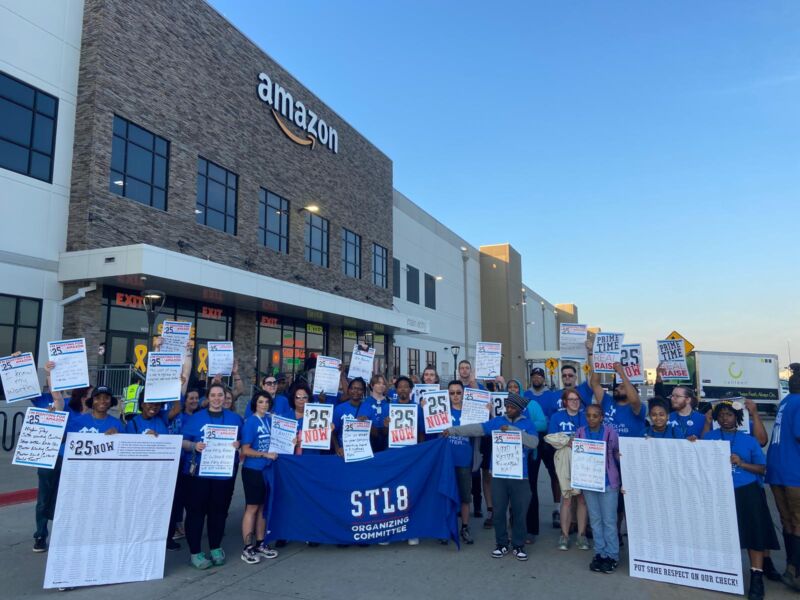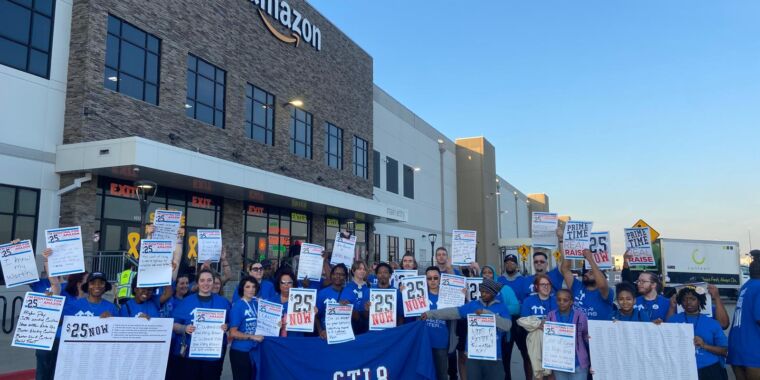
via Justice Speaks
Amazon currently faces disgruntled workers in every direction.
Office workers are raging against CEO Andy Jassy’s return to office mandate, Fortune reported—which came just as a leaked document reportedly showed that Amazon is also planning to gut management, Business Insider reported. Drivers by the hundreds are flocking to join a union to negotiate even better work conditions, CNBC reported, despite some of the biggest concessions in Amazon’s history. And hundreds more unionized warehouse workers are increasingly banding together nationwide to demand a $25 an hour minimum wage. On Wednesday, workers everywhere were encouraged to leave Jassy a voicemail elevating workers’ demands for a $25 minimum wage.
Putting on the pressure
This momentum has been building for years after drivers unionized in 2021. And all this collective fury increasingly appears to be finally pressuring Amazon into negotiating better conditions for some workers.
Just last week, Amazon ponied up $2.1 billion—its “biggest investment yet”—to improve driver safety and increase drivers’ wages.
Unionizing warehouse workers told Ars that they’re seeking a similar investment from Amazon, which currently pays on average a $20.50 minimum wage.
“We work at a breakneck pace,” Christine Manno, an Amazon Fulfillment Center worker at Amazon site STL8 in St. Louis, Missouri, who was injured and never expects to work again, told Ars. “We put smiles on the billionaire’s faces, and we feel it’s prime time for a real raise for the employees. There’s too many of us struggling with food and housing, yet Andy Jassy took home over $14,000 an hour last year and Amazon is making billions in profit.
On Wednesday, Amazon seemed to finally bend to the warehouse workers’ pressure, announcing a compromise on wage increases. The company said it was investing $2.2 billion to raise the base salaries of hourly fulfillment workers to “more than $22 an hour, and more than $29 an hour including benefits,” Reuters reported. Amazon’s spokesperson told Ars that STL8 workers’ starting wage “increased to $19 per hour coupled with our industry-leading benefits” and claimed that the company’s “biggest ever investment” in fulfillment workers was simply “part of an annual process where we review wages and benefits to ensure they stay competitive—and in many cases industry-leading.”
But while workers claimed the victory, they’re not going to sit back and take the pay bump. An STL8 worker on the organizing committee with Manno, Ash Judd, told Ars that workers “made this $1.50 raise happen through our tireless organizing, and we’ll keep fighting until we reach $25.”
Because of recent gains and the increasingly dire economic plight of workers, Amazon workers likely won’t be easing off the e-commerce giant any time soon. Some office workers told Fortune they are seeking other remote work to avoid returning to the office, threatening to “soft quit” and claiming that Amazon is going “backwards” with a stricter office policy than pre-COVID times. “This is a layoff in disguise,” one apparent worker complained on Reddit. “Return to the office or you’re fired and we don’t have to pay any severance or unemployment.”
With so many workers upset, it could now be a question of when Amazon will cave to their growing demands—not if—according to Beth Gutelius, the research director of the University of Illinois Chicago’s Center for Urban Economic Development.
“Research shows that the presence of collective bargaining agreements creates upward pressure on wages and working conditions, both in facilities that are unionized and those that are not,” Gutelius told Ars. “Based on that evidence, I would expect working conditions at Amazon to improve.”
Gutelius co-authored a May report documenting the financial insecurity of Amazon warehouse workers by surveying more than 1,400 across 42 states.

